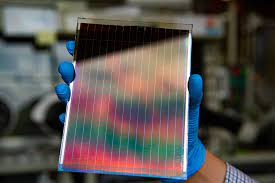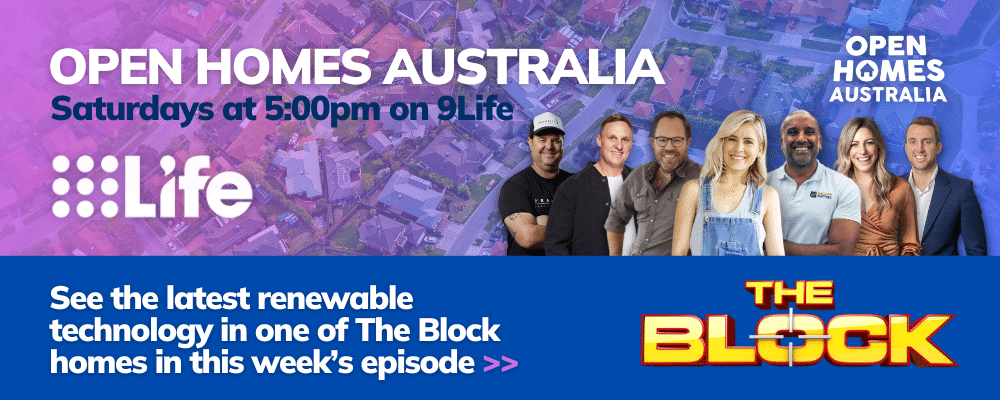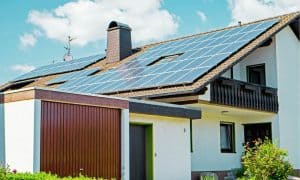Australia is at the forefront of solar energy innovation. Here, we will explore exciting new trends like perovskite solar cells promising high efficiency and low costs, transparent solar panels offering aesthetic appeal, and solar skins for sustainable buildings.
AI is also playing a growing role, optimising energy use in microgrids and potentially streamlining solar panel maintenance. We’ll also look at advancements in energy storage solutions with virtual power plants and second-life batteries.
Perovskite solar cells
You have probably heard of “perovskite solar cells” being thrown around a lot these days. An emerging solar technology trend, this type of solar cell is known to deliver more efficiency with low production costs. Currently, the technology is still in development as significant research studies continue that will bring the technology to commercialisation and eventually be used in homes.

Researchers are focused on achieving efficiencies above 30% and ensuring the technology can withstand Australian weather conditions. However, they still need further development for large-scale, cost-effective manufacturing suitable for the residential solar market.
CSIRO is heavily involved in research of perovskite solar cells and is currently exploring new designs and processes to increase perovskite solar cell performance. The agency is also researching ways to make perovskite materials compatible with glass products.
Last year, a team from the Royal Melbourne Institute of Technology (RMIT) University’s School of Science developed a machine learning model for the fast production of perovskite solar cells. Their research has resulted in reproducible perovskite solar cells with power-conversion efficiencies of 16.9%
Transparent solar panels
Transparent solar cells or PV glass are designed to provide various transparency levels. They are see-through solar panels often made of glass and are built for aesthetic purposes. Australia has been proactive in adopting this type of technology. One company that has made significant progress in this technology is ClearVue. They installed their technology in Skylab in Singapore and luxury properties in Canberra.

Notably, in 2020, a research team from Monash University and the ARC Centre of Excellence in Exciton Science delivered transparent perovskite class cells with a 17% efficiency at 10% transparency.
These panels are still in their early stages and not yet widespread, but with the developments in the past years, it’s one of the solar technologies to watch out for in 2024 and beyond.
Solar skins
Solar skins are a new technology with adoption in the early stages. Australia is at the forefront of solar skin development with Melbourne leading the way with two projects. The first one is at an eight-story office building on Spencer Street, which will be the first in Australia with a full “solar skin” facade. It is expected to be finished within the year.

Another project in Melbourne is a 48-story office tower at 435 Bourke Street will also feature a solar facade generating 20% of the building’s base power needs with a planned completion in 2026.
Solar skins are another new solar technology to watch out for. They represent a promising innovation for sustainable building design. While still in the early stages, the successful completion of pilot projects pave the way for wider adoption in the coming years.
AI-optimised solar energy systems
The Federal Government has invested a significant amount of money in the nation’s clean energy transition. The 2023-2024 budget outlines plans to spend over $40 million to make the country a renewable energy superpower.

Another emerging trend in solar technology is AI-optimised solar energy systems with a focus on distributed energy management and microgrids. For one, smart grid integration is equipped with AI to optimise energy use within a local community with solar power installations. With this, it can predict energy demand, manage battery storage across multiple homes, and even facilitate peer-to-peer energy trading between households. As a result, it can improve grid stability and potentially lower electricity costs for residents.
For one, Reposit Power is using AI-powered software that manages home solar and battery systems while considering user behaviour, weather patterns, and grid conditions. They offer a ‘No Bill Guarantee’, which includes a solar and battery system managed by their AI-powered smart controller.
AI-powered solar panel maintenance and cleaning is also another trend to look out for. However, there are no companies that are solely focused on this service yet. With AI in this service, it can analyse weather patterns, historical soiling data, and sensor information to determine the optimal cleaning schedule for your panels. Therefore, cleaning only happens when necessary, saving water and potentially reducing costs.
AI can analyse images of your panels to detect dust, debris, or shading issues early on, allowing for proactive maintenance and keeping your system running at peak efficiency.
While widespread adoption of AI-powered cleaning might take some time, there are promising signs in Australia. Existing monitoring companies might integrate AI features to recommend cleaning based on performance data. Tech startups are developing targeted AI solutions, and some forward-thinking cleaning companies might already be using AI-powered tools for analysing panels.
Advancements in energy storage solutions
Australians are seeing two exciting trends emerge in solar energy storage. Virtual Power Plants (VPPs) connect rooftop solar panels and home batteries from multiple homes into a single network. It can buy and sell energy back to the grid, helping to stabilise it and potentially earning Australians with solar systems extra income. VPPs also promote a more community-based storage energy system.

Currently, there are several programs and retailers offering VPPs. For one, AGL, a major Australian energy retailer has partnered with companies to develop VPPs that aggregate household solar and battery systems.
Another notable option is Origin Loop VPP, which offers a unique opportunity for solar battery owners to maximise their energy savings. Origin Loop VPP is a virtual power plant designed to enhance the value of your solar battery system. By connecting your battery to the grid, Origin Loop VPP allows you to earn credits for the energy you export during peak demand periods. This innovative program not only helps you save on electricity bills but also contributes to the stability of the grid by utilising renewable energy sources effectively.
Simple Energy VPPx is a South Australian program that provides households a chance to participate in a VPP by installing Tesla Powerwall batteries alongside their solar panels.
Another trend is second-life battery storage, which involves reusing batteries from electric vehicles after they’re no longer ideal for cars. They can still offer valuable energy storage for home solar systems, providing a more affordable and environmentally friendly option compared to brand-new batteries.
The Clean Energy Council (CEC) advocates for clean energy solutions and provides information on VPPs and battery storage for AU households and businesses. Additionally, the Australian Renewable Energy Agency (ARENA) offers funding and support for renewable energy projects, including initiatives related to VPPs and battery storage solutions.
The role of government incentives
Government incentives have played a crucial role in making solar power a viable option for Australian homes and businesses. Programs like rebates on solar panel installations and feed-in tariffs, which credit homeowners for excess energy fed back to the grid, have significantly reduced upfront costs and encouraged investment in solar.
The Small-scale Renewable Energy Scheme (SRES) provides financial incentives for installing solar systems under 100kW, with rebate size depending on system details and location. The Large-scale Renewable Energy Target (LRET) focuses on larger projects like solar farms by setting renewable energy generation targets and providing financial benefits for projects that meet them. While the LRET can slightly increase electricity prices, both programs aim to boost Australia’s use of renewable energy.
To know more about 2024 government solar rebates and incentives, click here.
A bright future is ahead
From potentially game-changing perovskite cells to aesthetically pleasing transparent solar panels and energy-harvesting building facades, innovation is booming. AI is on the rise too, optimising energy use and even automating panel maintenance. With advancements in storage solutions like virtual power plants and second-life batteries, Australians can look forward to a more sustainable and cost-effective solar future.










































